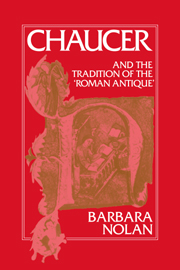Book contents
- Frontmatter
- Contents
- Acknowledgments
- List of abbreviations
- Introduction
- 1 Benoît de Sainte-Maure's Roman de Troie and the compositional practices of the roman antique
- 2 Plaits, debates, and judgments in the Roman de Thèbes, the Roman de Troie and the Roman d'Eneas
- 3 The poetics of fine amor in the French romans antiques
- 4 From history into fiction: Boccaccio's Filostrato and the question of foolish love
- 5 Boccaccio's Teseida and the triumph of Aristotelian virtue
- 6 Saving the poetry: authors, translators, texts, and readers in Chaucer's Book of Troilus and Criseyde
- 7 The consolation of Stoic virtue: Chaucer's Knight's Tale and the tradition of the roman antique
- Epilogue
- Notes
- Bibliography
- Index
7 - The consolation of Stoic virtue: Chaucer's Knight's Tale and the tradition of the roman antique
Published online by Cambridge University Press: 11 September 2009
- Frontmatter
- Contents
- Acknowledgments
- List of abbreviations
- Introduction
- 1 Benoît de Sainte-Maure's Roman de Troie and the compositional practices of the roman antique
- 2 Plaits, debates, and judgments in the Roman de Thèbes, the Roman de Troie and the Roman d'Eneas
- 3 The poetics of fine amor in the French romans antiques
- 4 From history into fiction: Boccaccio's Filostrato and the question of foolish love
- 5 Boccaccio's Teseida and the triumph of Aristotelian virtue
- 6 Saving the poetry: authors, translators, texts, and readers in Chaucer's Book of Troilus and Criseyde
- 7 The consolation of Stoic virtue: Chaucer's Knight's Tale and the tradition of the roman antique
- Epilogue
- Notes
- Bibliography
- Index
Summary
When we turn to Chaucer's Knight's Tale, we might expect that it, like Troilus and Criseyde, would be styled a “book,” particularly since, like Troilus, it is a translation of one of Boccaccio's opere. We do not know exactly when Chaucer composed the Knight's Tale, nor what manuscript of the Teseida he used as the basis for his translation. Yet the Knight's Tale is decidedly not like Troilus, nor is it like the Teseida, either in its tone or in its teaching. It is not a “book” in the poet's description of it, but a “tale,” part of the larger “Book of the Tales of Caunterbury.” It is, to be sure, one of the most formally structured of the tales, carefully divided into scholastic partes, and it participates in the tradition of the roman antique? But by comparison with Troilus it is considerably less complex and, as I argue here, less comforting and less resolved in its conclusion.
Chaucer may have made an earlier version of the young Thebans' love story, closer in conception and metrical form to the Teseida. In the Legend of Good Women (c. 1384–86?), he claims to have written a “book” detailing “al the love of Palamon and Arcite/ Of Thebes” (F 420), and this work may not be the Knight's Tale as we now have it. His Anelida and Arcite (c. 1375–79) shows that he had tried at one point to imitate Boccaccio's compositional practices in the Teseida, rather than using its amorous story line.
- Type
- Chapter
- Information
- Chaucer and the Tradition of the Roman Antique , pp. 247 - 281Publisher: Cambridge University PressPrint publication year: 1992

